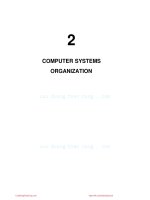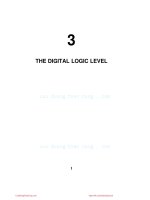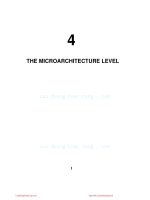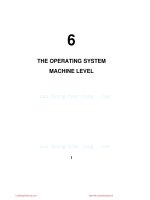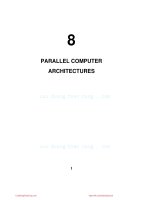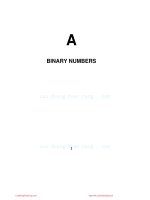kiến trúc máy tính dạng thanh tin figs 2 computer systems organization sinhvienzone com
Bạn đang xem bản rút gọn của tài liệu. Xem và tải ngay bản đầy đủ của tài liệu tại đây (215.71 KB, 42 trang )
2
COMPUTER SYSTEMS
ORGANIZATION
CuuDuongThanCong.com
/>
Central processing unit (CPU)
Control
unit
Arithmetic
logical unit
(ALU)
I/O devices
Registers
…
…
Main
memory
Disk
Printer
Bus
Fig. 2-1. The organization of a simple computer with one CPU and
two I/O devices.
CuuDuongThanCong.com
/>
A+B
A
Registers
B
A
B
ALU input register
ALU input bus
ALU
A+B
ALU output register
Fig. 2-2. The data path of a typical von Neumann machine.
CuuDuongThanCong.com
/>
public class Interp {
static int PC;
// program counter holds address of next instr
static int AC;
// the accumulator, a register for doing arithmetic
static int instr;
// a holding register for the current instruction
static int instr type;
// the instruction type (opcode)
static int data loc;
// the address of the data, or −1 if none
static int data;
// holds the current operand
static boolean run bit = true;
// a bit that can be turned off to halt the ma
public static void interpret(int memory[ ], int starting address) {
// This procedure interprets programs for a simple machine with instructions
// one memory operand. The machine has a register AC (accumulator), used
// arithmetic. The ADD instruction adds an integer in memory to the AC, for e
// The interpreter keeps running until the run bit is turned off by the HALT ins
// The state of a process running on this machine consists of the memory, the
// program counter, the run bit, and the AC. The input parameters consist of
// of the memory image and the starting address.
PC = starting address;
while (run bit) {
instr = memory[PC]; // fetch next instruction into instr
PC = PC + 1;
// increment program counter
instr type = get instr type(instr); // determine instruction type
data loc = find data(instr, instr type);// locate data (−1 if none)
if (data loc >= 0)
// if data loc is −1, there is no operand
data = memory[data loc];
// fetch the data
execute(instr type, data);
//execute instruction
}
}
private static int get instr type(int addr) { ... }
private static int find data(int instr, int type) { ... }
private static void execute(int type, int data){ ... }
}
Fig. 2-3. An interpreter for a simple computer (written in Java).
CuuDuongThanCong.com
/>
S1
S2
S3
S4
S5
Instruction
fetch
unit
Instruction
decode
unit
Operand
fetch
unit
Instruction
execution
unit
Write
back
unit
(a)
S1:
1
S2:
2
3
4
5
6
7
8
9
1
2
3
4
5
6
7
8
1
2
3
4
5
6
7
1
2
3
4
5
6
1
2
3
4
5
6
7
8
9
S3:
S4:
S5:
1
2
3
4
5
Time
(b)
…
Fig. 2-4. (a) A five-stage pipeline. (b) The state of each stage as a
function of time. Nine clock cycles are illustrated.
CuuDuongThanCong.com
/>
S1
Instruction
fetch
unit
S2
S3
S4
S5
Instruction
decode
unit
Operand
fetch
unit
Instruction
execution
unit
Write
back
unit
Instruction
decode
unit
Operand
fetch
unit
Instruction
execution
unit
Write
back
unit
Fig. 2-5. (a) Dual five-stage pipelines with a common instruction
fetch unit.
CuuDuongThanCong.com
/>
S4
ALU
ALU
S1
S2
S3
Instruction
fetch
unit
Instruction
decode
unit
Operand
fetch
unit
S5
LOAD
STORE
Floating
point
Fig. 2-6. A superscalar processor with five functional units.
CuuDuongThanCong.com
/>
Write
back
unit
Control unit
Broadcasts instructions
8 × 8 Processor/memory grid
Processor
Memory
Fig. 2-7. An array processor of the ILLIAC IV type.
CuuDuongThanCong.com
/>
Local memories
Shared
memory
CPU
CPU
CPU
CPU
Shared
memory
CPU
CPU
CPU
CPU
Bus
(a)
Bus
(b)
Fig. 2-8. (a) A single-bus multiprocessor. (b) A multicomputer
with local memories.
CuuDuongThanCong.com
/>
Address
Address
1 Cell
Address
0
0
0
1
1
1
2
2
2
3
3
3
4
4
4
5
5
5
6
6
16 bits
7
7
(c)
8
12 bits
9
(b)
10
11
8 bits
(a)
Fig. 2-9. Three ways of organizing a 96-bit memory.
CuuDuongThanCong.com
/>
Computer
Burroughs B1700
IBM PC
DEC PDP-8
IBM 1130
DEC PDP-15
XDS 940
Electrologica X8
XDS Sigma 9
Honeywell 6180
CDC 3600
CDC Cyber
Bits/cell
1
8
12
16
18
24
27
32
36
48
60
Fig. 2-10. Number of bits per cell for some historically interesting
commercial computers.
CuuDuongThanCong.com
/>
Address
Big endian
Address
Little endian
0
0
1
2
3
3
2
1
0
0
4
4
5
6
7
7
6
5
4
4
8
8
9
10
11
11
10
9
8
8
12
12
13
14
15
15
14
13
12
12
Byte
Byte
32-bit word
32-bit word
(a)
(b)
Fig. 2-11. (a) Big endian memory. (b) Little endian memory.
CuuDuongThanCong.com
/>
Big endian
Transfer from
big endian to
little endian
Little endian
0
J
I
M
4
S
M
I
T
8
H
0
0
12
0
16
0
M
I
J
J
I
M
T
I
M
S
S
M
I
T
4
0
0
0
H
H
0
0
0
8
12
21 0
0
0
0
0
0 21 12
16
4
0
0
0
0
1
M
I
J
0
T
I
M
S
4
0
0
0
0
H
8
0
0 21
0
0
0 21
0
1
0
0
1
(a)
4
(b)
4
Transfer and
swap
1
(c)
0
4 16
(d)
Fig. 2-12. (a) A personnel record for a big endian machine. (b)
The same record for a little endian machine. (c) The result of
transferring the record from a big endian to a little endian. (d) The
result of byte-swapping (c).
CuuDuongThanCong.com
/>
Word size
8
16
32
64
128
256
512
Check bits Total size Percent overhead
4
12
50
5
21
31
6
38
19
7
71
11
8
136
6
9
265
4
10
522
2
Fig. 2-13. Number of check bits for a code that can correct a single
error.
CuuDuongThanCong.com
/>
A
0
1
1
C
A
A
0
0
1
0
1
1
0
1
1
1
C
0
Parity
bits
B
(a)
1
0
0
B
C
Error
0
B
(c)
(b)
Fig. 2-14. (a) Encoding of 1100. (b) Even parity added. (c) Error
in AC.
CuuDuongThanCong.com
/>
Memory word 1111000010101110
0
1
0
2
1
3
0
4
1
5
1
6
1
7
0
8
0 0 0 0 1 0 1 1 0 1 1 1 0
9 10 11 12 13 14 15 16 17 18 19 20 21
Parity bits
Fig. 2-15. Construction of the Hamming code for the memory
word 1111000010101110 by adding 5 check bits to the 16 data
bits.
CuuDuongThanCong.com
/>
Main
memory
CPU
Cache
Bus
Fig. 2-16. The cache is logically between the CPU and main
memory. Physically, there are several possible places it could be
located.
CuuDuongThanCong.com
/>
4-MB
memory
chip
Connector
Fig. 2-17. A single inline memory module (SIMM) holding 32
MB. Two of the chips control the SIMM.
CuuDuongThanCong.com
/>
Registers
Cache
Main memory
Magnetic disk
Tape
Optical disk
Fig. 2-18. A five-level memory hierarchy.
CuuDuongThanCong.com
/>
Intersector gap
or
ect
1s
ta bits
6 da
409
P
ble
am
re
Track
width is
5–10 microns
E
C
C
Direction
of arm
motion
Width of
1 bit is
0.1 to 0.2 microns
Dire
c
Preamb
le
Read/write
head
tion
of
d
isk
40
96
da
ta
rot
ati
on
bit
s
C
C
E
Disk
arm
Fig. 2-19. A portion of a disk track. Two sectors are illustrated.
CuuDuongThanCong.com
/>
Read/write head (1 per surface)
Surface 7
Surface 6
Surface 5
Surface 4
Surface 3
Direction of arm motion
Surface 2
Surface 1
Surface 0
Fig. 2-20. A disk with four platters.
CuuDuongThanCong.com
/>
Parameters
Size (inches)
Capacity (bytes)
Tracks
Sectors/track
Heads
Rotations/min
Data rate (kbps)
Type
LD 5.25′′
5.25
360K
40
9
2
300
250
Flexible
HD 5.25′′
5.25
1.2M
80
15
2
360
500
Flexible
LD 3.5′′
3.5
720K
80
9
2
300
250
Rigid
HD 3.5′′
3.5
1.44M
80
18
2
300
500
Rigid
Fig. 2-21. Characteristics of the four kinds of floppy disks.
CuuDuongThanCong.com
/>
Name
Data bits
SCSI-1
8
Fast SCSI
8
Wide Fast SCSI
16
Ultra SCSI
8
Wide Ultra SCSI
16
Ultra2 SCSI
8
Wide Ultra2 SCSI
16
Bus MHz
5
10
10
20
20
40
40
MB/sec
5
10
20
20
40
40
80
Fig. 2-22. Some of the possible SCSI parameters.
CuuDuongThanCong.com
/>
(a)
(b)
Strip 0
Strip 1
Strip 2
Strip 3
Strip 4
Strip 5
Strip 6
Strip 7
Strip 8
Strip 9
Strip 10
Strip 11
Strip 0
Strip 1
Strip 2
Strip 3
Strip 0
Strip 1
Strip 2
Strip 3
Strip 4
Strip 5
Strip 6
Strip 7
Strip 4
Strip 5
Strip 6
Strip 7
Strip 8
Strip 9
Strip 10
Strip 11
Strip 8
Strip 9
Strip 10
Strip 11
Bit 1
Bit 2
Bit 3
Bit 4
Bit 5
Bit 6
Bit 7
RAID level 0
(c)
RAID level 2
Bit 1
Bit 2
Bit 3
Bit 4
Parity
RAID level 3
(d)
(e)
(f)
RAID
level 1
Strip 0
Strip 1
Strip 2
Strip 3
P0-3
Strip 4
Strip 5
Strip 6
Strip 7
P4-7
Strip 8
Strip 9
Strip 10
Strip 11
P8-11
Strip 0
Strip 1
Strip 2
Strip 3
P0-3
Strip 4
Strip 5
Strip 6
P4-7
Strip 7
Strip 8
Strip 9
P8-11
Strip 10
Strip 11 RAID level 5
Strip 12
P12-15
Strip 13
Strip 14
Strip 15
P16-19
Strip 16
Strip 17
Strip 18
Strip 19
RAID level 4
Fig. 2-23. RAID levels 0 through 5. Backup and parity drives are
shown shaded.
CuuDuongThanCong.com
/>
Spiral groove
Pit
Land
2K block of
user data
Fig. 2-24. Recording structure of a Compact Disc or CD-ROM.
CuuDuongThanCong.com
/>

